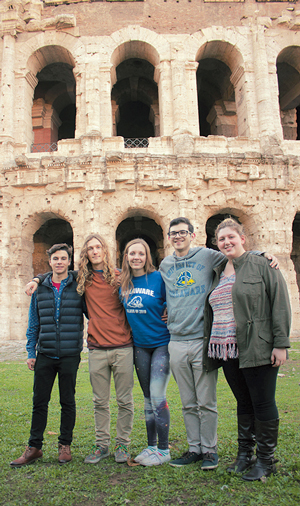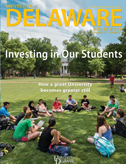
Shaping a class
An inside look at admissions and enrollment at the University of Delaware
Mike wasn’t the textbook 4.0 automatic shoe-in. And yet there was something special about him.
He was eager, his excitement at high school visits so palpable that Jackie Tatnall opened his online application with bated breath. He was good, she knew, but was he good enough?
The assistant admissions director soon exhaled. The coursework he had taken was rigorous, the essay compelling, and his recommendations vouched solidly for his ability. The second reader on the application—all undergraduate applications to UD are read by a minimum of two admissions counselors—agreed. He was in. He started last fall.

When Tatnall bumped into him a few months back, a beaming Mike told her about the fraternity he had joined and how he had made the Dean’s List. “And he said, ‘Thank you. I’m so excited for my future,” she remembers. “He’s probably not a student we would have admitted if we went solely off the numbers.”
In fact, Mike is one of thousands of students (from more than 27,000 applicants) who comprise “that middle ground” of students walking the border between outright acceptance and flat out rejection. Part intuitive detective and part data analyst, Tatnall and her fellow admissions professionals must add a pinch of tea-leaf reading when it comes to Blue Hens like Mike.
That’s when they turn from their spreadsheets and programs and put a closer focus on the factors that no computer could ever assess. They check with guidance counselors, and search for signs that measure performance against rigor. They patiently await the release of the next term’s grades, and pay closer attention to the essays and recommendation letters.
“They’re the students who really want to be here,” Tatnall says. “It’s our duty to take the extra time to fully look at their records.”

And, in the end, if the decision’s still just too close to call, the counselors gather together and talk it out as a group. It’s impossible to be certain the decision they make is ultimately the correct one—but they do know they can do everything they can to be fair.
And they realize that the consequences of their commitment is crucial—for the student, and for UD itself.
Standing out, reaching out
In many regards, UD is performing well in the never-ending competition for students. Over the prior two years, UD enrolled the highest quality and most diverse classes in history, and both classes exceeded enrollment goals. The ability to offer competitive financial aid has been central to our enrollment success, and given the admissions environment, will be critical for future success.
The Northeast has the highest density of colleges and universities in the world. And approximately 85 percent of students attend a school near their home, making the Delaware region especially aggressive.
At the same time, the current recruiting environment is becoming increasingly volatile. According to the National Center for Education Statistics, the proportion of high school graduates is expected to decline over the next decade, particularly in the Northeast.
For UD, this means a critical need to expand beyond the Northeast, now the source of 85 percent of the enrollment.
And where we tap is increasingly driven by where we already are.
The alumni connection
Illinois, Ohio, Missouri, Georgia, Florida, California, Colorado and the Carolinas are just some of the domestic markets in which the University hopes to expand, due in part to a large and growing alumni base.
“Our alumni are our strongest and most impactful advocates,” says Michael Sclafani, associate vice president for alumni engagement and annual giving at the University.
A casual conversation with a friend’s college-aged kid. A bumper sticker. A UD hoodie at the grocery store. It all adds up. In fact, the incremental impact of such tacit endorsement is not all that different from the situations admissions counselors face across the country when marketing the University.
“I can go to one school in Connecticut and it’s packed with students who want to come to Delaware,” says Amanda Gearhart, who manages recruitment in the New England states. “Then I’ll drive 10 miles down the road and one or two students might stroll by.”
How is that possible?
“It typically takes that one student to come back home and share how much they love UD,” Tatnall explains. “Every person connected to UD is an admissions ambassador.”
World Scholars
Ultimately, though, the admissions question is a big one.
“It is a buyer’s market,” says Chris Lucier, vice president of enrollment management. “And it really boils down to ‘why UD?’”
To help the University stand out from the pack, he and other leaders have been creating unique programs and exceptional opportunities to attract would-be Blue Hens.
UD makes test scores optional for Delaware applicants
In a four-year pilot program set to get underway in fall 2017, the University will make submission of SAT and ACT test scores optional for first-year applicants from Delaware—a move that is expected to open doors for the many students who show promise of success, but who tend to perform poorly on tests, making them reluctant to even apply.
Frequently, those students are from historically under-represented groups—the very groups UD realizes it must reach in order to truly serve the community, encourage campus diversity and stay competitive in a changing admissions market. Those efforts are already being supported by such programs as UD’s Commitment to Delawareans (C2D), which provides financial aid and an academic roadmap for admission. Since 2010, UD has provided more than $57 million in financial aid from C2D and other institutional sources for Delaware students.
“There are likely many outstanding Delawareans, students who challenged themselves, worked hard and performed well in their high schools, who are not applying to UD because they assume their scores on the SAT or ACT will disqualify them from admission,” says Doug Zander, director of admissions at UD. “We know that these students can be successful in college and we want them to apply.”
National data indicate that low scores are frequently tied to cultural biases in the tests rather than shortcomings in the students, says Chris Lucier, vice president of enrollment management at UD.
Research shows a strong predictive measure of success is a student’s GPA—a cumulative performance that’s four years in the making, as opposed to the more limited measure of a single test, on a single day.
UD now joins a growing list of about 850 U.S. colleges and universities—including close to 200 schools designated “top tier” by U.S. News and World Report—that no longer require applicants to submit results from the SAT or ACT.
One such initiative, the World Scholars Program, launched in fall 2015 to provide high achieving students an immersive, four-year global experience. Unlike any other global study program, it includes multiple semesters of learning abroad, beginning in the first semester of a student’s freshman year with partner institutions in Rome or Madrid (with more global sites to come), and concluding with a special World Scholar designation at graduation.
It has already helped give UD an edge over competitor institutions. Carl Valentino, AS19, turned down Penn State, UMass-Amherst and the University of Maryland-College Park to enroll in the program.
“Immersing yourself in the world like this is not an opportunity I could pass up,” says the New Jersey native. “I’d recommend it to anyone.”
In fact, all of his 37 fellow Scholars echo this sentiment.
Ally Chelst, AS19, considered taking a gap year to travel before realizing she could do that—and earn college credit.
“It taught me to be open-minded and patient, to better understand myself and my interests,” she says. “And it got me out of my comfort zone—just talking to people, taking initiative, saying hi to someone I didn’t really know. I couldn’t imagine a better first semester.”
Why UD
And yet there are so many variations for what that first semester at UD can be.
The new Delaware Innovation Fellows Program, administered by the Horn Program in Entrepreneurship, offers students in any major a four-year experience in the design and development of new solutions to real problems. Throughout their time at UD, fellows have an opportunity to engage with successful inventors, educators, entrepreneurs, business executives and community leaders. They can launch their own ventures, and benefit from plenty of resources, including grant dollars, internships, mentorships and other professional development.
“There are not too many places that have an offering like that,” says Dan Freeman, director of the Horn Program. He sees the Innovation Fellows Program as a crucial step toward making entrepreneurship education a campus-wide effort, and also a key University asset for attracting top students and building momentum.
Another new program, Delaware in D.C., gives students on UD’s wait list for admission the opportunity to spend their fall semester at American University in Washington, D.C., where—in addition to classes—they take part in a three-credit mentored internship at one of many leading organizations in the District, giving them a head start in gaining valuable field experience before they even walk onto the UD campus.
“The top reasons students choose a college or university are its academic excellence and outcomes,” says Lucier. “We have to be able to articulate what we can offer, because students are applying to eight to 10 universities. They are shopping around and looking for the best return on their investment."
For UD—and for its future—that means a constant investment in their continued success.



